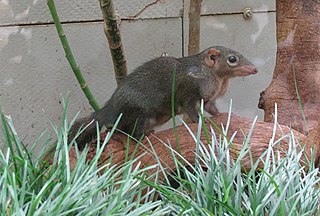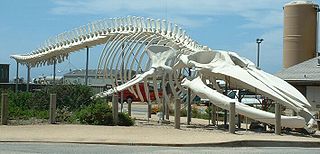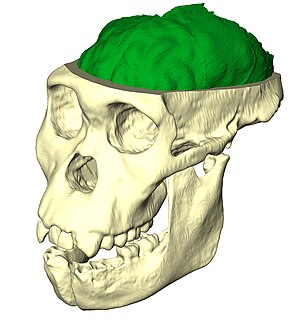
A brain is an organ that serves as the center of the nervous system in all vertebrate and most invertebrate animals. It is located in the head, usually close to the sensory organs for senses such as vision. It is the most complex organ in a vertebrate's body. In a human, the cerebral cortex contains approximately 14–16 billion neurons, and the estimated number of neurons in the cerebellum is 55–70 billion. Each neuron is connected by synapses to several thousand other neurons. These neurons typically communicate with one another by means of long fibers called axons, which carry trains of signal pulses called action potentials to distant parts of the brain or body targeting specific recipient cells.

The central nervous system (CNS) is the part of the nervous system consisting primarily of the brain and spinal cord. The CNS is so named because the brain integrates the received information and coordinates and influences the activity of all parts of the bodies of bilaterally symmetric and triploblastic animals—that is, all multicellular animals except sponges and diploblasts. It is a structure composed of nervous tissue positioned along the rostral to caudal axis of the body and may have an enlarged section at the rostral end which is a brain. Only arthropods, cephalopods and vertebrates have a true brain.

The treeshrews are small mammals native to the tropical forests of South and Southeast Asia. They make up the entire order Scandentia, which split into two families: the Tupaiidae, and the Ptilocercidae.
Cetacean intelligence is the cognitive ability of the infraorder Cetacea of mammals. This order includes whales, porpoises, and dolphins.

The cerebrum, telencephalon or endbrain, is the largest part of the brain containing the cerebral cortex, as well as several subcortical structures, including the hippocampus, basal ganglia, and olfactory bulb. In the human brain, the cerebrum is the uppermost region of the central nervous system. The cerebrum develops prenatally from the forebrain (prosencephalon). In mammals, the dorsal telencephalon, or pallium, develops into the cerebral cortex, and the ventral telencephalon, or subpallium, becomes the basal ganglia. The cerebrum is also divided into approximately symmetric left and right cerebral hemispheres.

The neocortex, also called the neopallium, isocortex, or the six-layered cortex, is a set of layers of the mammalian cerebral cortex involved in higher-order brain functions such as sensory perception, cognition, generation of motor commands, spatial reasoning and language. The neocortex is further subdivided into the true isocortex and the proisocortex.
Encephalization quotient (EQ), encephalization level (EL), or just encephalization is a relative brain size measure that is defined as the ratio between observed to predicted brain mass for an animal of a given size, based on nonlinear regression on a range of reference species. It has been used as a proxy for intelligence and thus as a possible way of comparing the intelligences of different species. For this purpose it is a more refined measurement than the raw brain-to-body mass ratio, as it takes into account allometric effects. Expressed as a formula, the relationship has been developed for mammals and may not yield relevant results when applied outside this group.

Evolutionary neuroscience is the scientific study of the evolution of nervous systems. Evolutionary neuroscientists investigate the evolution and natural history of nervous system structure, functions and emergent properties. The field draws on concepts and findings from both neuroscience and evolutionary biology. Historically, most empirical work has been in the area of comparative neuroanatomy, and modern studies often make use of phylogenetic comparative methods. Selective breeding and experimental evolution approaches are also being used more frequently.

A poikilotherm is an animal whose internal temperature varies considerably. Poikilotherms have to survive and adapt to environmental stress. One of the most important stressors is temperature change, which can lead to alterations in membrane lipid order and can cause protein unfolding and denaturation at elevated temperatures. It is the opposite of a homeotherm, an animal which maintains thermal homeostasis. While the term in principle can apply to all organisms, it is generally only applied to animals, and mostly to vertebrates. Usually the fluctuations are consequence of variation in the ambient environmental temperature. Many terrestrial ectotherms are poikilothermic. However some ectotherms remain in temperature-constant environments to the point that they are actually able to maintain a constant internal temperature .It is this distinction that often makes the term "poikilotherm" more useful than the vernacular "cold-blooded", which is sometimes used to refer to ectotherms more generally.
The size of the brain is a frequent topic of study within the fields of anatomy, biological anthropology, animal science and evolution. Brain size is sometimes measured by weight and sometimes by volume. Neuroimaging intelligence testing can be used to study the volumetric measurements of the brain. Regarding "intelligence testing", a question that has been frequently investigated is the relation of brain size to intelligence. This question is quite controversial and will be addressed further in the section on intelligence. The measure of brain size and cranial capacity is not just important to humans, but to all mammals.

The northern treeshrew is a treeshrew species native to Southeast Asia.

The largest body part is either the largest given body part across all living and extinct organisms or the largest example of a body part within an existing species. The largest animals on the planet are not the only ones to have large body parts, with some smaller animals actually having one particularly enlarged area of the body.

Cat intelligence is the capacity of the domesticated cat to solve problems and adapt to its environment. Researchers have shown feline intelligence to include the ability to acquire new behavior that applies knowledge to new situations, communicating needs and desires within a social group and responding to training cues.
The principles that govern the evolution of brain structure are not well understood. Brain to body size scales allometrically. Small bodied mammals have relatively large brains compared to their bodies whereas large mammals have smaller brain to body ratios. If brain weight is plotted against body weight for primates, the regression line of the sample points can indicate the brain power of a primate species. Lemurs for example fall below this line which means that for a primate of equivalent size, we would expect a larger brain size. Humans lie well above the line indicating that humans are more encephalized than lemurs. In fact, humans are more encephalized than all other primates.

The subfamily Mormyrinae contains all but one of the genera of the African freshwater fish family Mormyridae in the order Osteoglossiformes. They are often called elephantfish due to a long protrusion below their mouths used to detect buried invertebrates that is suggestive of a tusk or trunk. They can also be called tapirfish.

Paleoneurobiology is the study of brain evolution by analysis of brain endocasts to determine endocranial traits and volumes. Considered a subdivision of neuroscience, paleoneurobiology combines techniques from other fields of study including paleontology and archaeology. It reveals specific insight concerning human evolution. The cranium is unique in that it grows in response to the growth of brain tissue rather than genetic guidance, as is the case with bones that support movement. Fossil skulls and their endocasts can be compared to each other, to the skulls and fossils of recently deceased individuals, and even compared to those of other species to make inferences about functional anatomy, physiology and phylogeny. Paleoneurobiology is in large part influenced by developments in neuroscience as a whole; without substantial knowledge about current functionality, it would be impossible to make inferences about the functionality of ancient brains.
Bite force quotient (BFQ) is the regression of the quotient of an animal's bite force in newtons divided by its body mass in kilograms. The BFQ was first applied by Wroe et al. (2005) in a paper comparing bite forces, body masses and prey size in a range of living and extinct mammalian carnivores, later expanded on by Christiansen & Wroe (2007). Results showed that predators that take relatively large prey have large bite forces for their size, i.e., once adjusted for allometry. The authors predicted bite forces using beam theory, based on the directly proportional relationship between muscle cross-sectional area and the maximal force muscles can generate. Because body mass is proportional to volume the relationship between bite force and body mass is allometric. All else being equal, it would be expected to follow a 2/3 power rule. Consequently, small species would be expected to bite harder for their size than large species if a simple ratio of bite force to body mass is used, resulting in bias. Applying the BFQ normalizes the data allowing for fair comparison between species of different sizes in much the same way as an encephalization quotient normalizes data for brain size to body mass comparisons. It is a means for comparison, not an indicator of absolute bite force. In short, if an animal or species has a high BFQ this indicates that it bites hard for its size after controlling for allometry.

Pain in cephalopods is a contentious issue. Pain is a complex mental state, with a distinct perceptual quality but also associated with suffering, which is an emotional state. Because of this complexity, the presence of pain in non-human animals, or another human for that matter, cannot be determined unambiguously using observational methods, but the conclusion that animals experience pain is often inferred on the basis of likely presence of phenomenal consciousness which is deduced from comparative brain physiology as well as physical and behavioural reactions.
The expensive tissue hypothesis (ETH) relates brain and gut size in evolution. It suggests that in order for an organism to evolve a large brain without a significant increase in basal metabolic rate, the organism must use less energy on other expensive tissues; the paper introducing the ETH suggests that in humans, this was achieved by eating an easy-to-digest diet and evolving a smaller, less energy intensive gut. The ETH has inspired many research projects to test its validity in primates and other organisms.














